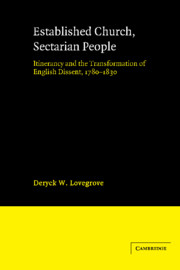 Established Church, Sectarian People
Established Church, Sectarian People Book contents
- Frontmatter
- Contents
- List of figures
- Preface
- Acknowledgements
- List of abbreviations
- 1 The Established Church and English Separatism
- 2 Itinerancy and Dissent
- 3 Preachers and sponsors
- 4 The academic leaven
- 5 Organization and infrastructure
- 6 Support and opposition
- 7 Criticism and legality
- 8 Developments and trends
- Conclusion
- Appendix A Journal of T[homas] Wastfield, June 1797–April 1798
- Appendix B Organizations active in itinerant evangelism
- Appendix C Baptismal statistics
- Notes
- Bibliography
- Index
8 - Developments and trends
Published online by Cambridge University Press: 13 October 2009
- Frontmatter
- Contents
- List of figures
- Preface
- Acknowledgements
- List of abbreviations
- 1 The Established Church and English Separatism
- 2 Itinerancy and Dissent
- 3 Preachers and sponsors
- 4 The academic leaven
- 5 Organization and infrastructure
- 6 Support and opposition
- 7 Criticism and legality
- 8 Developments and trends
- Conclusion
- Appendix A Journal of T[homas] Wastfield, June 1797–April 1798
- Appendix B Organizations active in itinerant evangelism
- Appendix C Baptismal statistics
- Notes
- Bibliography
- Index
Summary
Itinerancy challenged isolationism and brought to an end traditional quiescence but the transformation did not end there. It was soon apparent that the new activism was no more immune to change than earlier attitudes. As English society began to emerge from the difficulties of the Napoleonic era evangelical activity showed signs of settling down. During the second and third decades of the nineteenth century the freedom enjoyed by the early itinerants succumbed to a process of institutionalization. Evangelism came increasingly to be regarded as a denominational rather than local responsibility, and in spite of certain positive developments, the 1820s witnessed the first signs of formalism and stagnation, twin forces which in time sapped the recruiting power of Victorian Nonconformity.
When English Dissent first embraced itinerancy it entered a period of steady expansion. In order to stimulate interest organizers assiduously cultivated the religious public, emphasizing the numbers of preachers and hearers involved in the movement. They published full details of the places visited and the network of regular preaching stations established; they publicized the work of numerous itinerant societies, noting their growth in size and scale of operations and analysing their cost effectiveness. Unlimited progress appeared axiomatic: it was assumed by every enthusiastic observer. From the 1790s to the 1820s a mood of optimism gripped the majority of evangelical publications. Growth on such a scale was quite unprecedented. It merited and received extensive coverage in the religious periodical literature of the day.
- Type
- Chapter
- Information
- Established Church, Sectarian PeopleItinerancy and the Transformation of English Dissent, 1780–1830, pp. 142 - 161Publisher: Cambridge University PressPrint publication year: 1988
